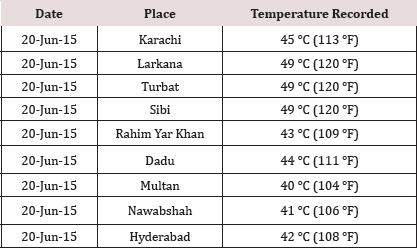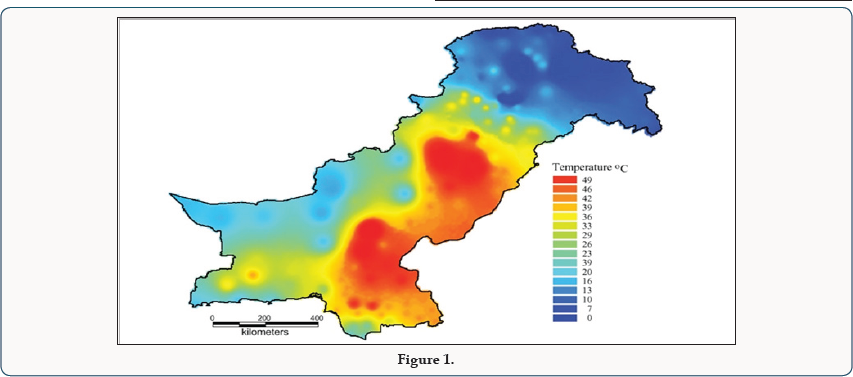Lupine Publishers | Journal of Health Research and Reviews
Abstract
Introduction
History
Heat waves are the most fatal type of weather situations. The first case was reported in Eastern North America in 1896 and this heat wave killed 1500 people but it also happens at irregular intervals in different countries. According to the Agency for Health care Research and Quality, about 6,200 Americans are hospitalized each summer due to excessive heat, and those at highest risk are poor, uninsured or elderly [4]. In 2003, more than 70,000 Europeans died as a result of the European heat wave [5]. The European heat wave of 2006 was the second giant heat wave to harm the continent in four years, with temperatures rising to 40 °C (104 °F) in Paris; In Ireland, which has a moderate maritime climate, temperatures of over 32 °C (90 °F) were reported. Highest average July temperatures were recorded at many locations in Great Britain, Netherlands, Denmark, Sweden and Germany. The past year, 2014, has been ranked the warmest year on record, driven by the accumulation of heat-trapping greenhouse gases in the atmosphere. However, 2015 is not too far behind. Nine of the 10 hottest years on record have all occurred in the 21st century.Extreme weather in Pakistan
The highest temperature ever recorded in Pakistan is 53.5 °C (128.3 °F) which was recorded in Mohenjo-daro, Sindh on 26 May, 2010. It was also the hottest reliably measured temperature ever recorded on the continent of Asia and the fourth highest temperature ever recorded on earth [6,7].Record-breaking 2010 summer heat wave
The hottest temperature ever recorded in Asia and the fourth highest temperature ever recorded in the world was in Mohenjo- daro, Sindh at 53.5 °C (128.3 °F) on May 26, 2010. Twelve cities in Pakistan had temperatures above 50 °C (122 °F) during the severe heat wave of summer 2010, which lasted from May 22 to May 31, 2010 [8]. On May 27, temperatures higher than 45 °C (113 °F) harmed areas across Pakistan and at least 18 people died as a result [9]. Also, during the extreme heat wave season, 11 cities experienced their highest ever recorded temperatures of 50 °C (122 °F) or above, and five cities experienced temperatures of 53 °C (127 °F). 11 cities also saw extremes of more than 45 °C (113 °F) but below 50 °C (122 °F). The previous record-temperature for Pakistan and for Asia was on June 12, 1919 at 52.8 °C (127 °F) at Jacobabad [10, 11].2015 summer heat wave and death toll in Pakistan
In Pakistan's Southern areas high temperatures were recorded . The temperature ranged from 49 °C (120 °F) in Larkana and Sibi to 45 °C (113 °F) in Karachi. In southern Punjab, 40 °C (104 °F) was recorded in Multan whereas several areas of the Balochistan province were also affected where temperature reached to 49 °C (120 °F) in Sibi and Turbat. In the Southern Pakistan, the death toll climbed to 1233 in 2015 because of the severe heat wave. Among them, 260 bodies were never identified. According to the officials, they were either homeless people who sleep rough on the streets or maybe drug addicts [12]. During this heat wave, around 65,000 people were treated in Karachi hospitals because of the heatstroke [13]. Elderly and poor were the worst affected groups. This heat wave was observed during the fasting month of Ramadhan which further worsen the situation along with power cuts.Recorded temperatures
Extreme temperatures started to grip Pakistan's southern areas on 18 June 2015, and peaked on 20 June [14,15] (Table 1) By 24 June 2015, the temperature and death records began to decline; the maximum temperature in Karachi was 37 °C (98 °F), and officials reported 58 deaths compared to 300 the prior day [16] (Figure 1).Table 1.

Figure 1.

How they occur
Heat waves form when high pressure aloft (from 10,000-25,000 feet (3,000-7,600 metres) become stronger and remains over a region for several days up to several weeks. This is common in summer (in both Northern and Southern Hemispheres) as out flux �follows the sun�. The high pressure area is on the equator side of the out flux, in the middle layers of the atmosphere. Summertime weather patterns are generally slower to change than in winter due to which this mid-level high pressure also moves slowly. The air sinks toward the surface under high pressure. This sinking air acts as a dome covering the atmosphere. This cap helps to trap heat instead of allowing it to lift. There is little or no convection without the lift and therefore little or no convective clouds with minimum chances for rain. So, the end product is a constant build-up of heat at the surface that people experience as a heat wave [17].Health risks
Our body produces heat, mostly during physical activities. Hot air, sun rays, and hot surfaces also heat up our body. This heat can be lost by contact with cool air and by sweat production, which cools our body as it evaporates. Weather situations play a huge role in how our body maintains its temperature. For example, if it's windy, sweat evaporates faster, which helps to cool.com. But high humidity slows down this process, aiding to increased body temperature. Heat illnesses can affect.com immediately, and can lead to long-lasting health problems and even death. They are caused by being over-exposed to intense heat especially if we are doing too much for our age and physical condition. Heat illnesses include: heat edema (swelling of hands, feet, and ankles), heat rash, heat cramps (muscle cramps), heat fainting, heat exhaustion and heat stroke. Extreme heat can keep everyone at risk from heat illnesses. Health older adults, infants and young children, people with chronic illnesses (like breathing problems, mental illness, and heart problems), human beings who work in the heat, people who exercise in the heat, homeless people and people with low-income.Security tips
There are number of things that people can do to help themselves from heat wave. These include. These include wearing damp clothes which will help lower the body's temperature, sticking one's hands in cold water, placing fans next to windows as this will draw air from outside, which should be cooler, wearing loose clothes, having a lukewarm shower rather than a cold one and fanning the face rather than other parts of the body [12]. Look for side effects of warmth illness, which include: dizziness or swooning, nausea or heaving, headache, rapid breathing and pulse, extreme thirst (dry mouth or sticky salivation), decreased pee with uncommonly dull yellow pee, changes of conduct in kids (like drowsiness or fits). When individual has any of these side effects during amazing warmth, move him to a cool place and beverage fluids immediately.Water is best. While sitting tight for help - cool the individual immediately by moving them to a cool spot, apply ice-cold water to major areas of their skin or garments, fan the individual however much as could sensibly be expected. Drink a lot of cool fluids (mainly water).Never leave individuals or pets inside a stopped vehicle or in direct daylight. When the outside air temperature is 23oC/73aF, the temperature inside a vehicle can be strikingly dangerous - more than 50oC/122oF.
Why so many people died in Karachi's heat wave
Karachi's heat wave resulted in high number of deaths which was the cumulative effect of Ramadan when people fast from dawn to dusk, prolonged electricity shortages, pollution, chronic water shortages and climatic change [12]. A person who survived with heat wave said that "It was difficult to breathe, as if the air had no oxygen". Majority of the people, including the authorities were not aware of the deadly impact of heat wave and no warnings were issued. The provincial government seemed completely unresponsive to this unfolding tragedy. Experts say that this heat wave is the result of phenomenon called "time mover". Scientists warned that heat wave will become more frequent and intense due to the climatic change but government is yet to recognise this impending threat. Many of these deaths could have been avoided if the people were provided with clean drinking water in access and had given early warnings in relation to heat wave [18].How to prevent future heat wave fatalities in Pakistan
People of Pakistan are not strange to high temperatures with sizzling hot and humid weather in summer but from the recent killings it is proved that the local government failed to prepare for and respond to the heat waves. Something must be done to overcome this deadly threat which is increasing day by day. Heat Health action plan must be established to raise the awareness of health risks and to train healthcare workers so that they can recognise the signs of heat stress. A coordinated action is needed to prepare for the rising threat and a forecast system needs to be developed that can alert the administration to impending heat waves several days out [18]. Along with that, excessive trees are planted and energy from other key sources must be availed to overcome energy crisis.Conclusion
For more Lupine Publishers Open Access Journals Please visit our website: h
http://www.lupinepublishers.us/
For more Journal of Research and Reviews on Healthcare Research articles Please Click Here:
https://lupinepublishers.com/research-and-reviews-journal/
http://www.lupinepublishers.us/
For more Journal of Research and Reviews on Healthcare Research articles Please Click Here:
https://lupinepublishers.com/research-and-reviews-journal/
To Know More About Open Access Publishers Please Click on Lupine Publishers
Follow on Linkedin : https://www.linkedin.com/company/lupinepublishers
Follow on Twitter : https://twitter.com/lupine_online
Follow on Linkedin : https://www.linkedin.com/company/lupinepublishers
Follow on Twitter : https://twitter.com/lupine_online


No comments:
Post a Comment